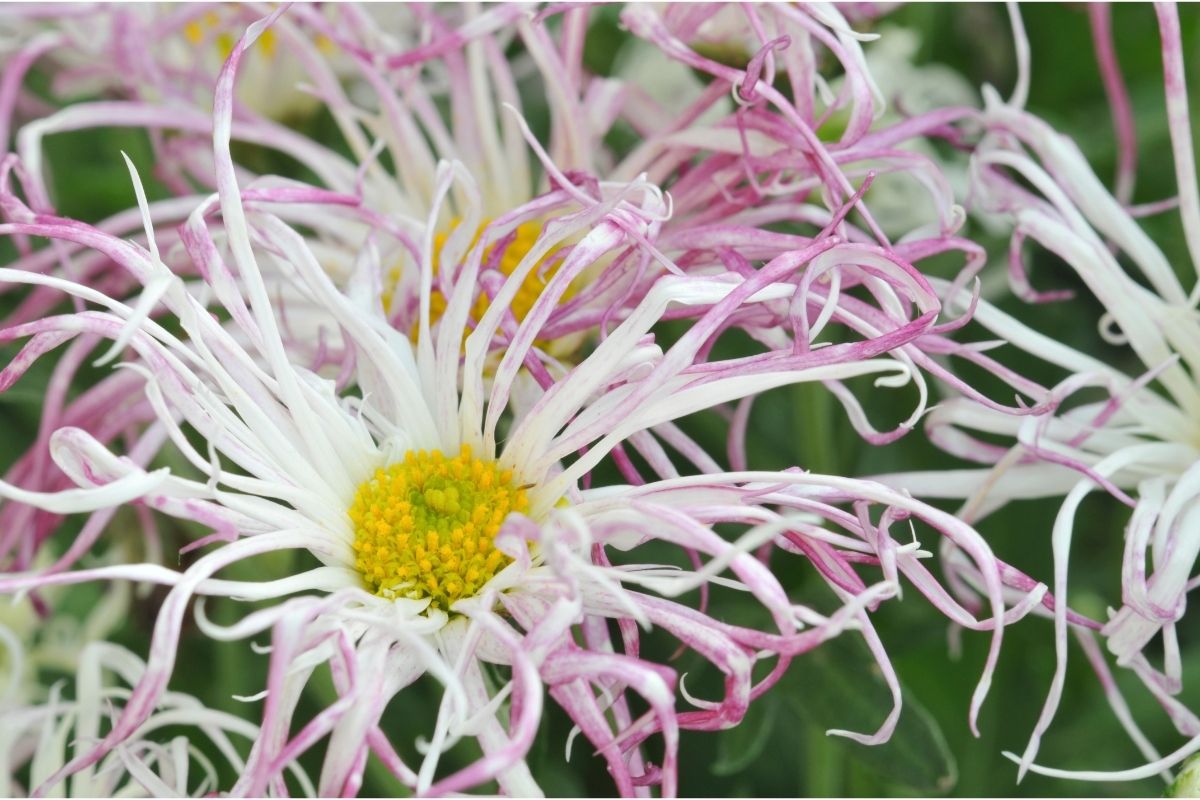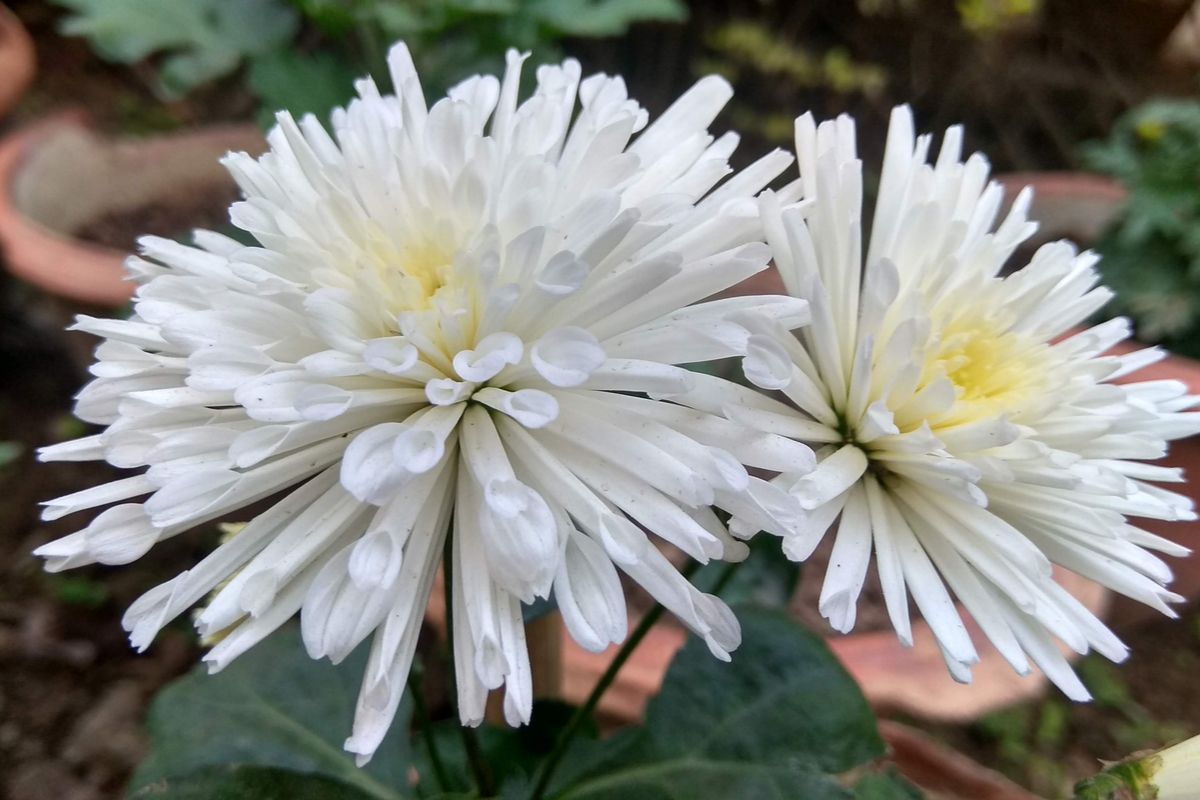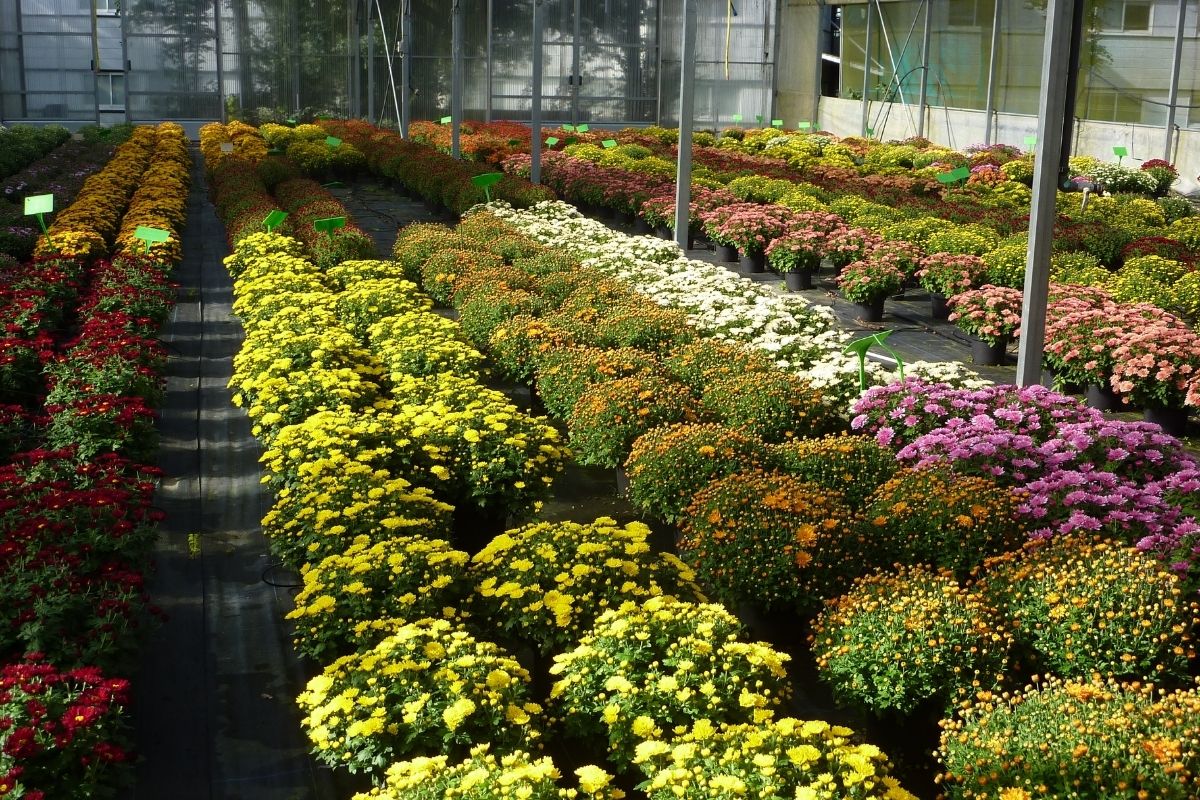Different types of Chrysanthemums (or ‘Mums’ or ‘Chrysanths’) are a group of absolutely beautiful perennial flowering plants in the family of Asteraceae.
The native range of these plants is incredibly large, being present from Northeastern Europe to the far east of Asia, with the majority of the plants and, as such, the center of their diversity being China itself.
Due to the variety of beautiful colors and shapes that Chrysanthemum’s take on, they are prized by gardeners and horticulturalists alike.
With a group of Chrysanthemum, you can literally theme your garden and design it as an architect or an interior designer would to a home.

People have given their gardens entirely one color range, for example an entirely yellow garden, or have created a haphazard rainbow in their gardens, all thanks to these plants.
It is not just the color, either. The shapes and sizes of the plants vary as much as the color.
With this in mind, you may be wondering whether there is any rhyme or reason to the Chrysanthemum family.
Well, all we can say is, don’t worry, for although there are many of these plants, there is an order in the bright and colorful chaos, and we are here today to take you through the different types of Chrysanthemum.
The Different Types Of Chrysanthemum
The problems with doing a list of the varieties of Chrysanthemum are that there are over 40 wild species of the plant and thousands of sub-varieties.
This is because the Chrysanthemum is the one of the most popular plants to grow in the world, alongside Cacti and Lilies, so people have been experimenting with different breeds for as long as we have been growing plants.
As such, we have narrowed this list down to the most popular Chrysanthemum plants and will give you a description of what they look like.
1. Single Blooms

These types of Chrysanthemums are generally the most widespread amongst gardeners, as they are quite nice for both indoor and outdoor displays.
The colors of this Chrysanthemum can vary, with some (like Icy Isle) being very reminiscent of a daisy, as they have white petals and a yellow center.
Others can have bright red or orange petals, which gives it a far more striking look, but they always retain the yellow center.
Nonetheless, this is where the similarities to daisies end, as a single bloom will have a much larger bloom than a daisy, at a couple of inches wide.
They will also have a host of petals per bloom overlapping one another, looking completely full of no gaps.
These plants can grow up to 2 to 3 feet tall, with the smallest being just under a foot, but can be quite delicate since they are herbaceous in nature.
2. Spider Blooms

The petals are what makes this Chrysanthemum variety so distinct, as they are not compact and uniform, like single blooms.
Instead, the petals are very thin and long with a certain tubular shape that sticks out and away from the center where they originate from.
Each one of these petals sticks out in different directions as well, but instead of looking like a mess, it makes the plant seem quite elegant.
Some spider blooms stick their petals upwards, while others still have buds at the end of their tubular petals, and they droop them dramatically.
The spider blooms also have a variety of colors, but the most popular are definitely the Symphony, which is a yellowy bronze color, while others are deep, rich purple.
The stem is long and thin on these Chrysanthemums, giving more credence to the plant’s elegance, and they can be as small as 6 inches or as large as 2 feet.
3. Quilted Blooms

Quilted Blooms actually bear quite a large resemblance to Spider Blooms, but there are key differences.
Imagine the shape of a quill for the end of the petal. The petals themselves are a lot more rigid and spiky than the Spider blooms as well, remaining determinedly pointing in their chosen direction.
The other point to make is that their center is very noticeable, whereas with Spider Blooms it can be somewhat hard to determine where exactly it is – though this depends on the plant.
While the center is noticeable, it is closed and surrounded on all sides by shorter petals. The blooms tend to be very large and beautifully colored, with a good example being the Lola, which has gorgeous lavender petals.
Quilted Blooms tend to be quite small, with most being not larger than 6 inches.
4. Anemone

Anemone Chrysanthemums follow a very different path from how the other Chrysanthemums have looked on this list thus far.
For the previous entrants, they have all had visible, but quite small centers surrounded by interesting petals.
However, the Anemone has an enormous center, up to a couple of inches wide, with very short petals surrounding it. The center is also completely raised and looks somewhat like a soft cushion or bean bag.
Although this variety of Chrysanthemum does come in a couple of different colors, the prominent color for the Anemone is purple and the various sub-varieties of purple.
The height of the bloom tends to stay around the 4-inch mark, but due to the amount of blooms on a bush, it still gives a stunning display.
5. Pompoms

Pompom Chrysanthemums produce blooms that are, relatively speaking, quite small compared to other Chrysanthemums.
They do not have a gigantic center like Anemones, nor do they stretch their leaves like Spider Blooms. Instead, their blooms are globe shaped, being circular all the way round.
The petals of this Chrysanthemum are all tiny, but they are all stacked together in a neat bundle. The slightly curved shape of the leaf creates the circular bloom and makes it look adorable.
The size of this plant is probably the most varied across the species, as some – such as the Lakeside variety – only grow to between 1 and 4 inches tall, but others – like the Moonbeam – can get up to 3 feet tall.
The colors of the Pompom Chrysanthemum are completely varied and do not have a set range that they stick to, but some of our favorites are the bright white pompoms and the deep pink pompoms.
6. Curved Blooms
Curved blooms come in two major varieties: the in-curve or the reflex – basically the outward curving or the inward curving bloom.
There are many Chrysanthemums that come under these two categories, but there is a further subdivision that has to be made, that of the inconsistent and irregular petals and that of the consistent and regular petals.
In-curve Blooms

So, to start off with, we will look at in-curve flowers. Most of these can grow to a maximum of 8 inches tall, but the majority stay around the 6-inch mark.
If the flower is an irregular in-curve bloom, then the head of the bloom will probably be quite large and have unusual petals that seem to be quite inconsistent and don’t form a uniform pattern.
Instead, they will overlap and push against one another in a mass.
If the flower is a regular in-curve bloom, then the bloom is not quite as large because it is more compact.
These flowers tend to be much more uniform and growing pattern, having an opening out the top while the bottom remains ball-like.
These types of Chrysanthemum have a higher chance of different colors appearing on individual petals, for example a separate yellow and red appearing on a petal in sunset tones, while these colors remain distinct.
Reflex Blooms

The Reflex Bloom varieties of Chrysanthemums are similar to irregular In-curve Blooms, but with their petals curving downwards.
Each one of these plants will have a flat center, and the petals themselves are long and droop quite far down away from the top of the bloom.
These blooms can be up to 5 inches in diameter, and their petals tend to overlap one another without order.
The colors are often very striking as they are much deeper, and they don’t tend to blend – similar to a watercolor painting – like other Chrysanthemums.
7. Decorative Blooms

These plants are more reminiscent of other plants, compared with a lot of Chrysanthemums. Their blooms are flat and short, with a distinct dark center that is much darker than the rest of the plant.
The way in which these plants stand out is their light colors with uniform, curved petals that form a perfect collar around their center.
These are normally the smallest of the Chrysanthemums and are only about 5 to 6 inches high at most, meaning they are perfect for small pots and even indoors if you are willing.
While the color range is big for decorative blooms, it tends to range from light yellow to deep orange most of the time.
8. Thistle Chrysanthemums

These plants are one of the unique looking. To us, they are very reminiscent of plants we imagine in a witch’s garden from fairy tales and lore.
The reason is that they have the thinnest petals of the Chrysanthemums. They are very long, very, very thin, and spread out from the center haphazardly, weaving their way over one another, until they make a circular shape.
They are certainly the most wild looking Chrysanthemum, and their wildness is only strengthened by the fact that the petals act differently from one another. Some droop, some stick up rigidly, and some still twist and weave into other petals.
These plants are quite small and generally will not grow higher than 2 inches, which adds to their look as a wildflower.
9. Spoon Blooms

Apart from having a lovely name, Spoon Blooms also have quite a unique look – which is saying something among Chrysanthemums.
Much like Quilted and Spider Mums, Spoon Blooms have long, slender petals that stick out from the bloom.
These petals are hollow and tubular, but what makes them unique is the appendages at the end of the petals. The end fans out into a flat, curved, circular shape, very similar to a spoon.
The bottom of the bloom is flat, while the rigidity of the petals means that the rest of the bloom is semicircular.
In terms of colors, normally Spoon Blooms are one solid color except in the center, where the bloom has a different, softer color that bleeds into petals the closer to the center that you get.
10. Unclassified

Despite all of these classifications, it is worth noting that some Chrysanthemums are part of a single variety.
Either they are given a separate variety like ‘Double Bloom’, due to being similar to Single Blooms but having more to them, or they are just too unique to fit into one category.
Most of the unclassified plants only grow up to 6 inches in height, but apart from that they are not uniform to each other at all.
Most have exotic looking petals that can resemble other Chrysanthemums, but they often have properties of two different types, for instance maybe it has tubular petals with a huge center.
A good example to look at is the Lone Star Chrysanthemum, which resembles a Spider Bloom, but with a much more densely compact center that is almost invisible. It also has some drooping petals and others that are quite rigid.
Conclusion
Chrysanthemums are a diverse and well-beloved family among gardeners and horticulturalists. They come in a huge variety of different colors, blooms, petals, and sizes.
The fact that they are all part of the same family with this much difference between them is extraordinary, but it doesn’t stop them being any less beautiful from one another.
If you are thinking about adding a Chrysanthemum to your garden, but are unsure which one appeals to you, take a look at each variety.
There are so many that you are almost spoiled for choice in what you pick.







